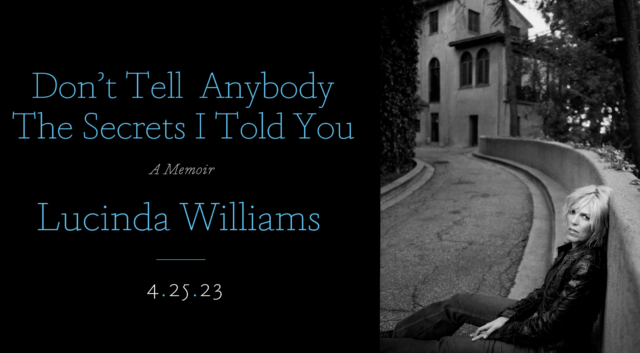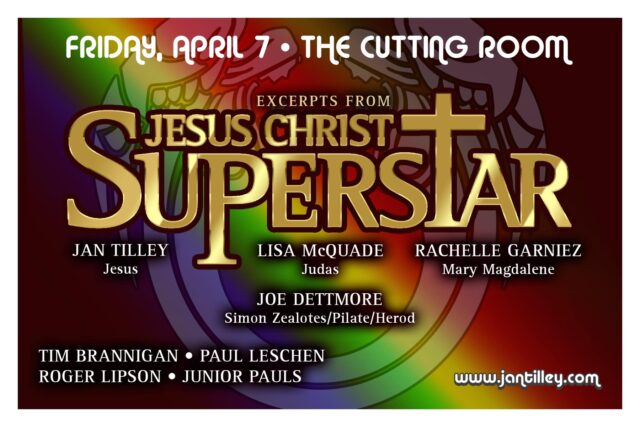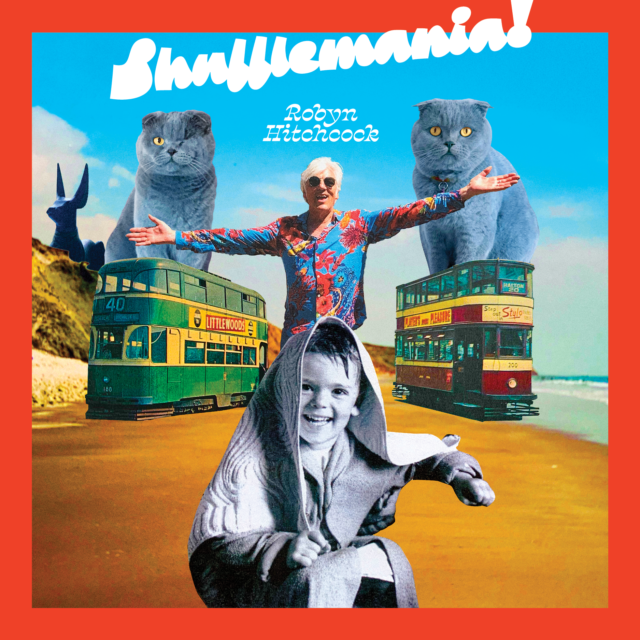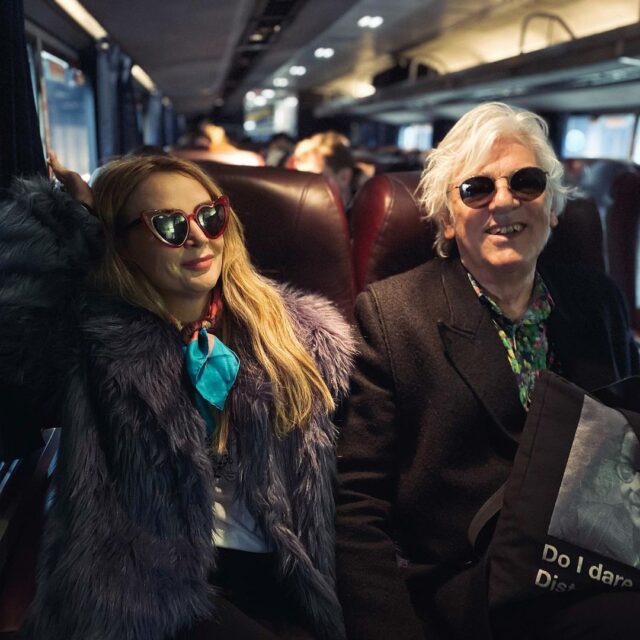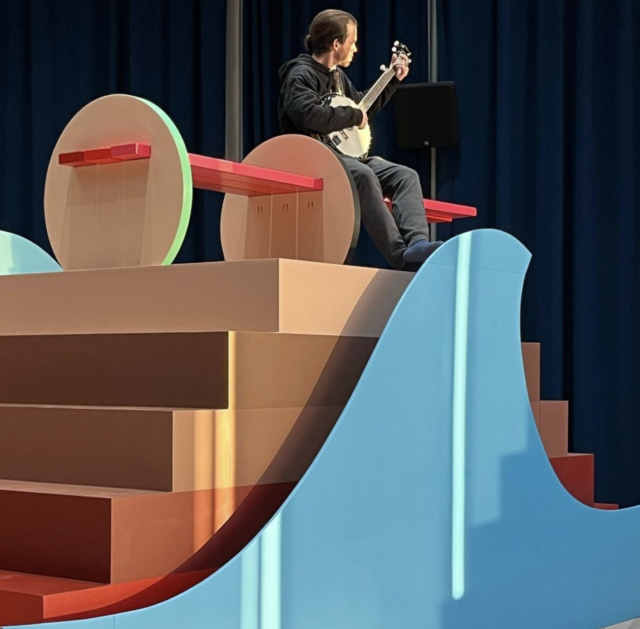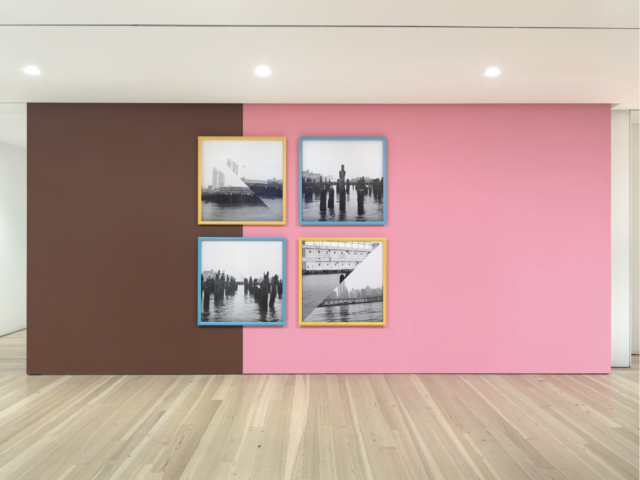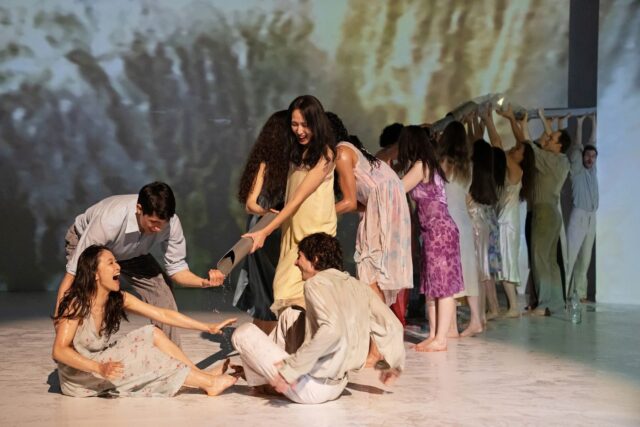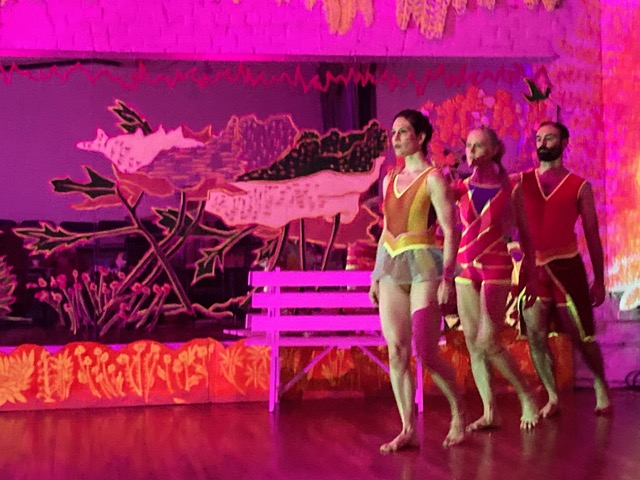
Alexandra Berger, Janet Charleston, and Christopher Williams rehearse Douglas Dunn’s Garden Party (photo by Mimi Gross)
GARDEN PARTY
Douglas Dunn Studio
541 Broadway between Spring & Prince Sts., third floor
April 24-30, $15-$20
www.douglasdunndance.com
www.mimigross.com
All dancer and choreographer Douglas Dunn needed to do was give Mimi Gross the title of his new production and the painter, set and costume designer, installation artist, and teacher was off to the races.
Born in California in 1942, Dunn has been collaborating with Gross, a native New Yorker born in 1940, since Dunn presented Foot Rules in 1979; they’ve worked together some two dozen times since, including on 1980’s Echo, 1981’s Skid, 1988’s Matches, 1995’s Caracole, 2007’s Zorn’s Lemma, and 2017’s Antipodes. They met quite serendipitously.
“I’d been working with Charles Atlas on film, video, and costumes for several years. Being then in a moment unavailable, he suggested Mimi,” Dunn explained via email. “She made wonderful apparel for an hour-long duet for Deborah Riley and me called Foot Rules. What I noticed right away was her love of color.”
“Charlie Atlas was presenting live performances which he made up and directed. That is how I first met Charlie, and then I met Douglas,” Gross added. “They had been making dances and videos together. When Douglas asked Charlie if he could make some costumes for a new dance he was choreographing with Deborah Riley, Charlie was super busy — he was working with Merce Cunningham full-time — and recommended me to do it. I had made many costumes for movies with cardboard and hot glue . . . nothing to be washed! Or worn many times! Quite a challenge. Of course, I said sure. And then through the decades on and off we have shared many projects, sets and costumes, sometimes sets, sometimes costumes, sometimes both — very open, warm, clear mutual caring to work within our shared possibilities, never knowing how it will come out.”
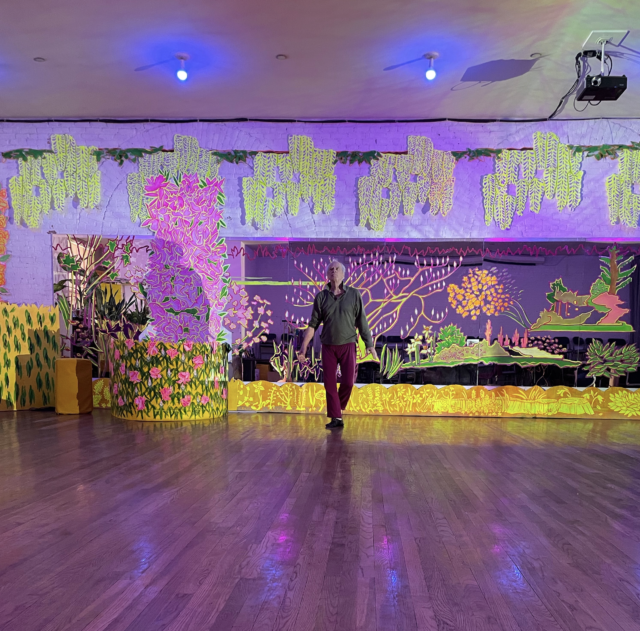
Douglas Dunn emerges from his pulpit in Mimi Gross’s fantastical Garden Party installation (photo by twi-ny/mdr)
Dunn and Gross are currently at work on their latest project, Garden Party, which runs April 24-30 at Douglas Dunn + Dancers’ SoHo loft studio. Last week I attended a rehearsal of the sixty-minute piece, which features Dunn, Grazia Della-Terza, Alexandra Berger, Janet Charleston, Vanessa Knouse, Emily Pope, Paul Singh, Jin Ju Song-Begin, Timothy Ward, and Christopher Williams moving through the spectacular space created by Gross, consisting of lushly painted trompe l’oeil walls and ceiling and a long horizontal mirror, covered with pink, yellow, and green flowers, plants and trees, clouds, raindrops, and more. While the plants at the right are fake — Dunn told me at the rehearsal that he had “planted” some of them himself — the greenery at the left is real, repurposing the plants that were already in the studio.
There’s also a colorful pulpit where Dunn spends much of the show; he had specifically requested it, asking for it to be based on the design at Grace Church on Broadway. The dancers glide across the floor like blossoming flowers, in solos, pas de deux, and trios, celebrating birth, life, and growth; however, the soundtrack of pop and classical songs (Robert de Visée, John Lennon & Yoko Ono, Bach, Mark Knopfler & Emmylou Harris, more), birdsong, and poetry (by John Keats, Anne Waldman, Molière, Rainer Maria Rilke, John Milton, Stephanie Jacco, and others, read by Dunn, Waldman, Jacco, and Della-Terza) touch on loss and loneliness. A few of the dancers occasionally sit on an inviting white park bench, and Dunn clutches a plush bird named April.
“Mimi always helps me see color; I always see line first,” Dunn explained. “We got along just fine and knew right away how much to interact and how much to let the other alone. She often saw historical references in the dancing and she’d take off from there. We’re both dead serious but also insistent on having a good warm time relating when preparing for a new dance show. The feel of this evening was clear to me the day the title hit me (about three years ago, the pandemic postponing the project). The lavish beauty of Mimi’s set completely fulfills my initial intuition . . . as if she’d read my dancing mind.”
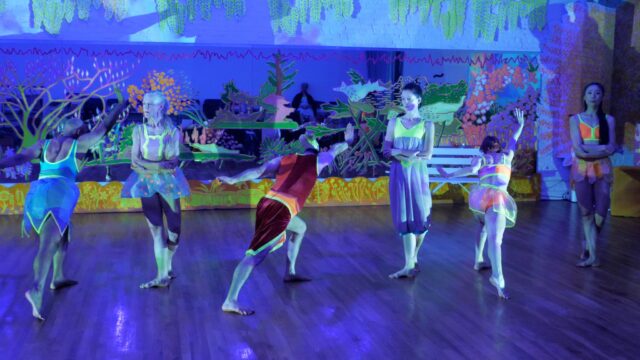
Douglas Dunn’s Garden Party runs April 24-30 in SoHo loft studio (photo by Jacob Burckhardt, 2023)
“The new dance had been talked about a long while ago,” Gross noted. “All of 2021-22, I made many landscape drawings, and then, when the pandemic seemed to subside, I painted these flowers last summer and called them ‘Feel Good Flowers.’ When Douglas asked me if I would make a garden and sets about ‘Early Spring,’ he said, ‘Fill up the studio.’ That was just what I was doing anyway. I asked him if I could paint it with this stylization, and that I didn’t know exactly how I would do it. He was fine with that. I made a big drawing of a bird and discussed the texture and color with Sue Julien, who fabricated it. Both Sue and David Quinn made an amazing contribution fabricating the costumes from my drawings. Douglas wanted each dancer to be different, with different leg lengths. That is all he had said. I pored over my Ballet Russe books, and Charles James and I made drawings. The only common link is the fluorescent yellow in each costume.”
The collaboration extends to Lauren Parrish, who designed the lighting and projections, and sound designer Jacob Burckhardt. The show will be preceded by live music from guitarist and composer Tosh Sheridan, who has released such albums as Tosh, Tosh Sheridan Trio, and solo/duo.
“All of these plain facts are fine and good and relate our collaborating history, but it is the depth of poetic reality where we really collaborate,” Gross concluded, “by dance and by making an atmosphere for the dance.”
And what an atmosphere Dunn and Gross have created for Garden Party.
